Confucius was a Chinese philosopher who lived from 551-479BC and is one of the most influential philosophers in human history. His teachings have influenced all of the Sinitic cultures whose lives have “evolved around ways of living and thinking derived from the wisdom” of Confucius (565). Instead of thinking about “great ideas”, Confucius focused his time on intellectual and social trends to improve the quality of life dependent upon them. Confucius’s status in society has been upgraded exponentially since his death from a minor official to a “God in China”. The Han dynasty established Confucianism as the state ideology and his teachings became an “unchallenged orthodoxy” (566).
Similar to Christianity, Confucius’s disciples wrote down his teachings in what is called the Lunyu Analects in an effort to preserve his way of thinking for future generations (566). However, the writings vary in nature from direct quotes of what he said to his mannerisms and conduct to his philosophies. The last five books of the Lunyu Analects focus more on the teachings of Confucius and are told as stories that his disciples are referencing him in rather than him having a physical presence in the situation (567).
One key aspect of these writings is that they are not written in a manner that people should dictate their lives a certain way, rather they are just an account of one man and his ways. Confucius saw living as “an art rather than a science” in that there is no set way to live your life but it is “something we all must participate in constructing”. This process is called “ren” (567).
Confucius was tolerant of difference and actively taught his disciples in a way that catered to their understanding rather than attempting to change the way they thought. Confucius had several favorite disciples that all stood for a different character trait present in humanity. For example, his disciple Zilu was rash, immodest, and patient while Ziwo was known to lack character. These flaws were used by Confucius in his teachings throughout the Analects (568-569).
Finally, the article mentions that the books of the Analects are compilations of other collections as well as scholars’ commentary. A majority of this literature is based on previous texts that have yet to be discovered, similar to the Q source in Christian literature. Also much like Christian literature, Confucian literature is being found and compared to the original texts to determine authenticity and accuracy (569-570).
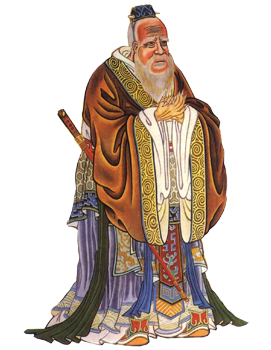 Confucius The Analects
I. Love or Reciprocity (Jen)
Tzu-kung asked, saying, “Is there one word which may serve as a rule of practice for all one’s life?” The Master said, “Is not reciprocity such a word? What you do not want done to yourself, do not do to others.” (15.23)
II. Justice and Kindness
Someone said, “What do you say concerning the principle that injury should be recompensed with kindness?” The Master said, “With what then will you recompense kindness? Recompense injury with justice, and recompense kindness with kindness.” (14.36)
III. The Superior Man
The Master said, “Riches and honors are what men desire. If they cannot be obtained in the proper way, they should not be held. Poverty and baseness are what men dislike. If they cannot be avoided in the proper way, they should not be avoided. … The superior man does not, even for the space of a single meal, act contrary to virtue.” (4.5)
The Kama Sutra is an ancient Hindu text that is meant to be guidelines for how to love and live a fulfilling life. It starts out by introducing the Hindu religion and its beliefs that life necessitated three kinds of activity: to assure its survival, its means of
existence, and its nourishment (Danéliou p. 1). The Hindu’s also believed that there are three aims in life: 1) (Artha) material goods assure survival 2) (Kama) erotic practice assures the transmission of life 3) (Dharma) rules of behavior, a moral nature, assures cohesion and duration of the species (Danéliou p. 2). The author of the Kama Sutra is Vātsyāyana who was a Brahman and known has a “great man of letters”. Although he is the author of the Kama Sutra, he did not write the text itself. The Kama Sutra is a compilation of various letters and texts that Vātsyāyana collected between 400 BCE and 200 CE in fear of them getting lost or ruined (Danéliou p. 3).
Alain Danéliou asserts this information within the first few pages of The Complete Kama Sutra. Danéliou also notes that, “eroticism is not pornographic, but the search for pleasure and that the goal of the techniques of love is to attain infinite delight” (Danéliou p. 5). Similar to other Hindu works, the Kama Sutra is written to be memorized with explanations provided by a teacher and in some cases the teacher is preferred to be female (Danéliou p. 5). The Kama Sutra is organized into 36 chapters broken down into 7 sections. In order to interpret the Hindu concepts the reader has to remember the teaching tradition and acknowledge the associated commentaries. Danéliou includes two commentaries in this text. One is the Jayamangala commentary, written in Sanskrit by Yashodhara during the Middle Ages, and the other is the modern commentary in Hindi by Devadatta Shastri (Danéliou p. 6). In today’s culture the Kama Sutra is widely thought of as a guide to human sexual behavior and practical advice on sexual intercourse.
The Kama Sutra
I.2
Kama is the enjoyment of appropriate objects by the five senses of hearing, feeling, seeing, tasting and smelling, assisted by the mind together with the soul. The ingredient in this is a peculiar contact between the organ of sense and its object, and the consciousness of pleasure which arises from that contact is called Kama.
The romance of the Silk Road can be traced back to medieval accounts of travelers and explorers like Marco Polo. Marco Polo wrote about the Silk Road en route from Baghdad to China. The Silk Road is described as the world’s earliest highway system that stretched from China to Rome. Only a small number of travelers made the entire journey. The term “Silk Road” was invented by German explorer and geographer Baron Ferdinand Von Richthofen in 1877 (9). In the 1930s, Mildred Cable and Francesca French (both explorers) called the Silk Road, a “great highway of Asia, which connected the Far East with distant European lands” (11). Throughout two millennia, luxuries such as silk and spices were transported along the Silk Road. In fact, the Silk Road is not just one singular road connecting Rome to China in trade. It is a highway system with various routes. The northern and southern routes follow strategically placed oasis settlements near mountain ranges for water and lodging. Hardly anybody traveled in the central routes because of the barrenness of the desert (13-14). The stock quality that most medieval travelers described the desert or the central area route was void of life. It was that emptiness and the problem of water that persuaded travelers to choose other trade routes on the Silk Road (18-19). Bandits were also a problem on the Silk Road (20). From fourteenth to the twentieth century accounts from traders and travelers on the Silk Road, all accounts agree that the highway had extremes of temperature and water along with a lack of animal life (21-22). While on the Silk Road, one would experience the great Taklamakan, Lop and Gobi deserts, mountains, the snowy Tian Shan and Kunjerab pass, and oasis towns along the way (14-16). George Babcock Cressey asserted that “in place of stating its [Silk Road] size in terms of distances, this region [central Asia] should be described as one which is six months from east to west and one month or more from north to south” (14). The Silk Road is a vast network in terms of size as Cressey stated but according to Wood, it was also a great place for the “profusion of peoples, costumes, religions and languages” that mixed together along the stops of bazaars and towns on a trader’s route on the Silk Road (25). The Silk Road was not only a highway for commodities but also culture exchange.
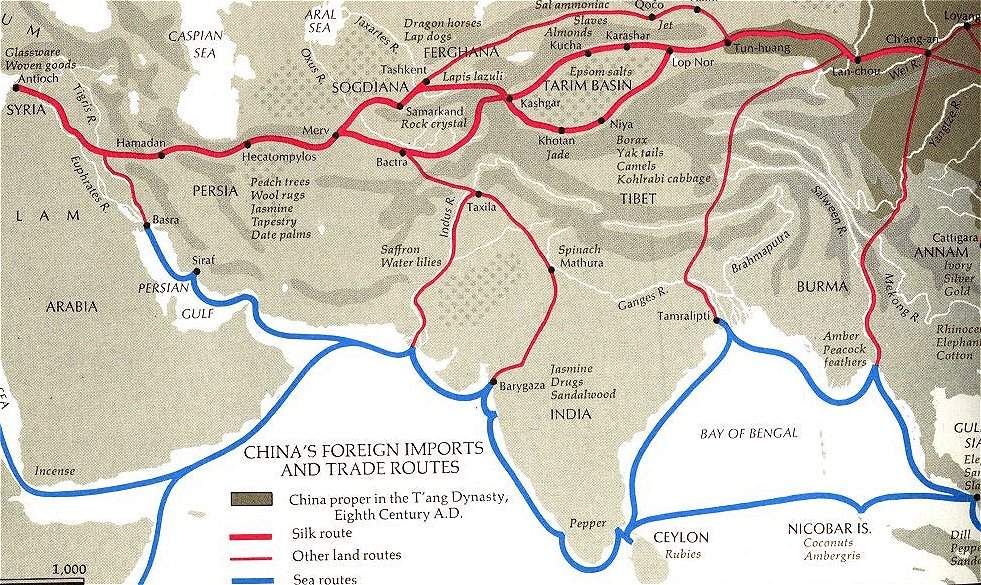 The Silk Road 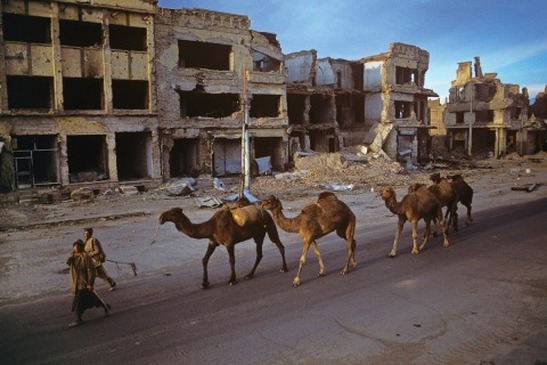 Kabul (1995)
Dao is one of the most popular Chinese philosophies worldwide. Dao can be translated to “the way.” It means “to lead along a path” or “to be led along it.” Dao believes that the human being broadens the way, not the way that broadens the human being. People make their own path, and the human dao is always under construction. Dao is both things and their attributes as well as actions and their modalities. Things and events cannot be separated.
Dao is a metaphysical concept that is concerned with explaining the fundamental nature of the human being and the world. The idea gave rise to the religion we know today as Daoism. The Daodejing, which is the written foundational text of Daoism, does not seek to provide a persuasive description of what dao might mean in the world around us, rather it aims to provide guidance for one on how to interact with the phenomena and humans that give us context in the world (Craig, p.778, 1998).
Dao is rarely an object of direct worship. It more of a divine concept rather than a physical being or item we can worship. It focuses on the natural world and the flow of the universe instead. The rise of Daoism made the concept more into a way to live, how to be and act, and what to do in the world. Dao is often taken to be the familiar search for the “One” behind the many. In Dao, there is only one true self. There is no being behind a being. “Continuity makes dao one; change makes dao myriad; change makes dao processional and provisional” (Craig, p.778, 1998).
In conclusion Dao seeks not give one the answers and truth, rather it provides a guide for each person to “find their way.” It helps us to interact with people, nature, and the rest of the world. Dao seeks to help us find the appropriate response to everyday occurrences in our life: how to act, how to think, and how to view the world.
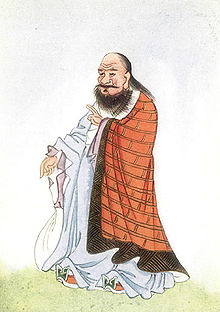 Lao-tzu The Tao Te Ching (Daodejing)
I. Tao
1. The Nature of Tao (1)
Tao that can be known is not Tao.
The substance of the World is only a name for Tao.
Tao is all that exists and may exist
2. Properties of Tao (4)
Tao is a depthless vessel;
Used by the Self, it is not filled by the World;
It cannot be cut, knotted, dimmed or stilled;
Its depths are hidden, ubiquitous and eternal;
I don't know where it came from;
It came before Nature.
3. The Continuity of Tao (14)
Looked at but cannot be seen - it is beyond form;
Listened to but cannot be heard - it is beyond sound;
Grasped at but cannot be touched - it is beyond reach;
These depthless things evade definition,
And blend into a single mystery.
II. Virtue (Te) (33)
Who understands the World is learned;
Who understands the Self is enlightened.
Who conquers the World has strength;
Who conquers the Self has love.
Who is contented has riches;
Who is determined has purpose.
III. Wu-wei (2; 43)
The sage controls without authority,
And teaches without words;
He lets all things rise and fall,
Nurtures, but does not interfere,
Gives without demanding,
And is content. …
The soft overcomes the hard;
The formless penetrates the impenetrable;
Therefore I value taking no action.
Teaching without words,
Work without action,
Are understood by no one.
Kali is a fearful and ferocious form of a mother goddess. In Elizabeth Harding’s book, Kali: The Black Goddess of Dakshineswar, she became powerful and popular by a Godly creature, Devi Mahatmya, developed in the 5th-6thcentury AD. In these writings she is depicted as having been born from the brow of Goddess Durga during one of her battles with the evil forces. In the battle, Kali destroyed and killed everything in sight. To stop her, Lord Shiva, begged her to stop and she stuck her tongue out in astonishment (xii)
The common image of Kali shows her with four arms, with a sword in one hand and the head of a demon in another. The other two hands bless her worshippers, and say, "fear not"! She has two dead heads for her earrings, a string of skulls as necklace, and a girdle made of human hands as her clothing. Her tongue protrudes from her mouth, her eyes are red, and her face and breasts are sullied with blood. She stands with one foot on the thigh, and another on the chest of her husband, Lord Shiva (Harding xxix).
When Joshua and Biff witness the bloody sacrifices to Kali, Joshua does not believe this is right. He believes the people shouldn't worship their God's this way. He says, "No more sacrifices, no more blood." I don't think he is only talking about the Hindu ways of worship, but Judaism worship as well. He believes they should be worshiping a God who does not make them sacrifice, he has feelings people should be worshiping his God or his father.
“For if we sin willfully after that we have received the knowledge of the truth, there remaineth no more a sacrifice for sins” is seen in the American Standard Version of the Bible in Hebrews 10:26. It goes along with what Joshua was expressing. His idea of sacrifice as silly and there are other ways to prove to your God your faith.
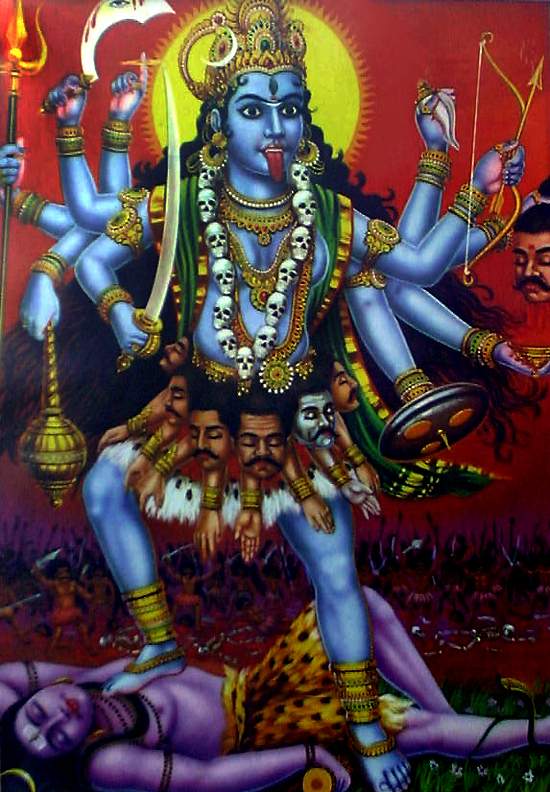 Kali
|








 RSS Feed
RSS Feed